Need some more reasons to keep the lake clean?
American Black Bear
The American black bear (Ursus americanus) is a medium-sized bear native to North America. It is the continent’s smallest and most widely distributed bear species. Black bears are omnivores with their diets varying greatly depending on season and location. They typically live in largely forested areas, but do leave forests in search of food. Sometimes they become attracted to human communities because of the immediate availability of food. The American black bear is the world’s most common bear species.
It is listed by the IUCN as a “least concern” species, due to its widespread distribution and a large global population estimated to be twice that of all other bear species combined. Along with the brown bear, it is one of only two of the eight modern bear species not considered globally threatened with extinction by the IUCN. American black bears often mark trees using their teeth and claws as a form of communication with other bears, a behavior common to many species of bears
Click the link (left), it can save your life!
Red-shouldered Hawk

The red-shouldered hawk (Buteo lineatus) is a medium-sized hawk. Its breeding range spans eastern North America and along the coast of California and northern to northeastern-central Mexico. Red-shouldered hawks are permanent residents throughout most of their range, though northern birds do migrate, mostly to central Mexico. The main conservation threat to the widespread species is deforestation.
Pileated Woodpecker

The pileated woodpecker (Dryocopus pileatus) is a very large North American woodpecker, roughly crow-sized, inhabiting deciduous forests in eastern North America, the Great Lakes, the boreal forests of Canada, and parts of the Pacific coast. It is also the largest woodpecker in the United States, except the possibly extinct ivory-billed woodpecker.
Belted Kingfisher
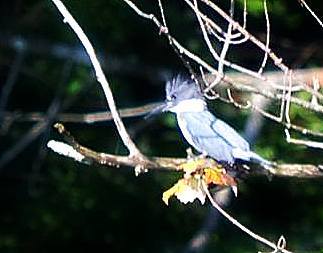
The belted kingfisher (Megaceryle alcyon) is a large, conspicuous water kingfisher, the only member of that group commonly found in the northern United States and Canada. It is depicted on the 1986 series Canadian $5 note. All kingfishers were formerly placed in one family, Alcedinidae, but recent research suggests that this should be divided into three. All six New World kingfishers, together with three Old World species, make up the new family Cerylidae.
Bluejay
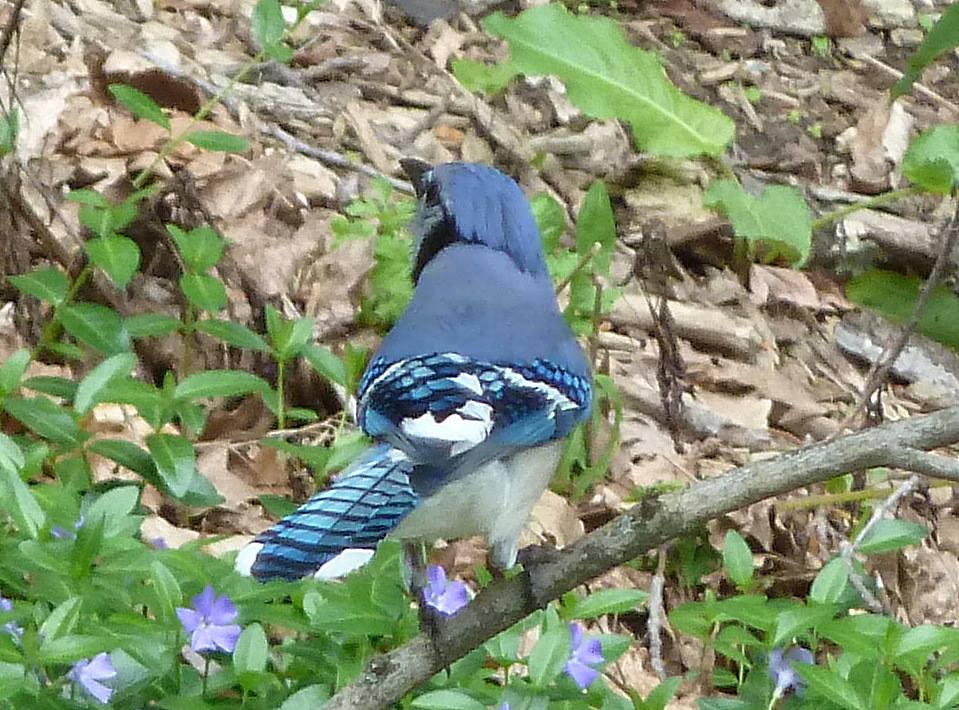
The blue jay (Cyanocitta cristata) is a passerine bird in the family Corvidae, native to North America. It is resident through most of eastern and central United States and southern Canada, although western populations may be migratory. It breeds in both deciduous and coniferous forests, and is common near and in residential areas. It is predominantly blue with a white chest and underparts, and a blue crest. It has a black, U-shaped collar around its neck and a black border behind the crest. Genders are similar in size and plumage, and plumage does not vary throughout the year. Four subspecies of the blue jay are recognized.
Red Fox

The red fox, Vulpes vulpes, is the largest of the true foxes and the most abundant wild member of the Carnivora, being present across the entire Northern Hemisphere from the Arctic Circle to North Africa, North America and Eurasia. It is listed as least concern by the IUCN. Its range has increased alongside human expansion, having been introduced to Australia, where it is considered harmful to native mammals and bird populations. Due to its presence in Australia, it is included among the list of the “world’s 100 worst invasive species”.
Belted Kingfisher

The Baltimore oriole (Icterus galbula) is a small icterid blackbird common in eastern North America as a migratory breeding bird. It received its name from the resemblance of the male’s colors to those on the coat-of-arms of Lord Baltimore. Like all New World orioles, it is named after an unrelated, physically similar family found in the Old World: the Oriolidae. Observations of interbreeding between the Baltimore oriole and the western Bullock’s oriole, Icterus bullockii, led to both being classified as a single species, called the northern oriole
Bald Eagle

The bald eagle (Haliaeetus leucocephalus, from Greek hali “sea”, aiētos “eagle”, leuco “white”, cephalos “head”) is a bird of prey found in North America. A sea eagle, it has two known subspecies and forms a species pair with the white-tailed eagle (Haliaeetus albicilla). Its range includes most of Canada and Alaska, all of the contiguous United States, and northern Mexico. It is found near large bodies of open water with an abundant food supply and old-growth trees for nesting.
Red Winged Blackbird

The red-winged blackbird (Agelaius phoeniceus) is a passerine bird of the family Icteridae found in most of North and much of Central America. It breeds from Alaska and Newfoundland south to Florida, the Gulf of Mexico, Mexico, and Guatemala, with isolated populations in western El Salvador, northwestern Honduras, and northwestern Costa Rica. It may winter as far north as Pennsylvania and British Columbia, but northern populations are generally migratory, moving south to Mexico and the southern United States.
Orb-weaver spider

The typical orb-weaver spiders (family Araneidae) are the most common group of builders of spiral wheel-shaped webs often found in gardens, fields and forests. Their common name is taken from the round shape of this typical web, and the taxon was formerly also referred to as the Orbiculariae.
Red Bellied Woodpecker
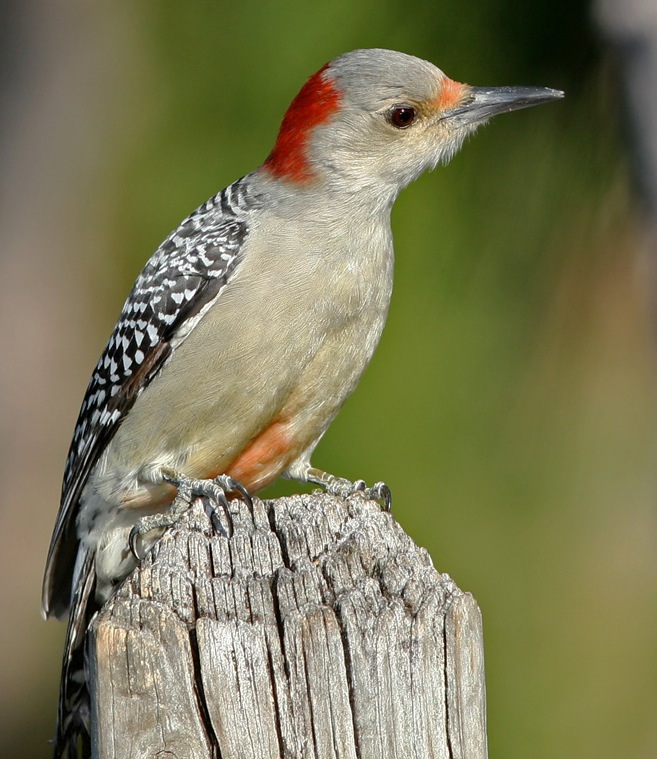
The red-bellied woodpecker (Melanerpes carolinus) is a medium-sized woodpecker of the Picidae family. It breeds in southern Canada, northeastern Mexico, and the northeastern United States, ranging as far south as Florida and as far west as Texas. Its common name is somewhat misleading, as the most prominent red part of its plumage is on the head; the red-headed woodpecker, however, is another species that is a rather close relative but looks quite different.
American Coot

The American coot (Fulica americana), also known as a mud hen, is a bird of the family Rallidae. Though commonly mistaken to be ducks, American coots belong to a distinct order. Unlike the webbed feet of ducks, coots have broad, lobed scales on their lower legs and toes that fold back with each step in order to facilitate walking on dry land. Coots live near water, typically inhabiting wetlands and open water bodies in North America. Groups of coots are called covers or rafts. The oldest known coot lived to be 22 years old.
Northern Flicker

The northern flicker (Colaptes auratus) is a medium-sized member of the woodpecker family. It is native to most of North America, parts of Central America, Cuba, the Cayman Islands, and is one of the few woodpecker species that migrate. There are over 100 common names for the northern flicker. Among them are: yellowhammer (as it’s known as the state bird of Alabama, not to be confused with the Eurasian yellowhammer), clape, gaffer woodpecker, harry-wicket, heigh-ho, wake-up, walk-up, wick-up, yarrup, and gawker bird.
Gray Cat Bird
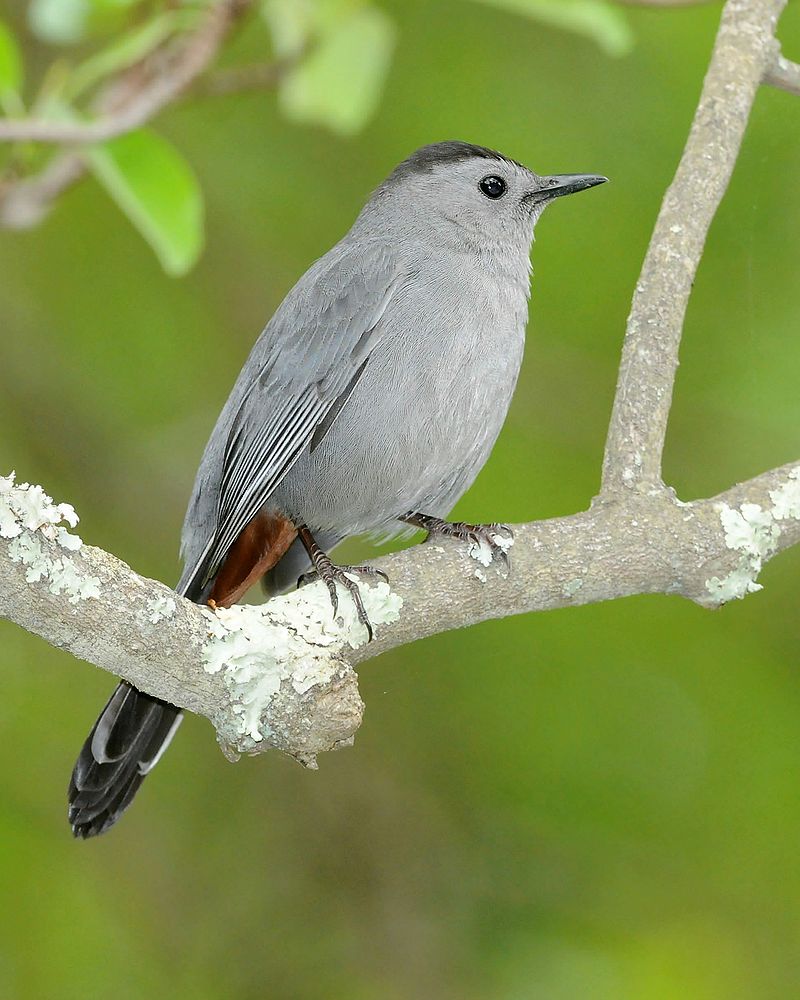
The gray catbird (Dumetella carolinensis), also spelled grey catbird, is a medium-sized North American and Central American perching bird of the mimid family. It is the only member of the “catbird” genus Dumetella. Like the black catbird (Melanoptila glabrirostris), it is among the basal lineages of the Mimidae, probably a closer relative of the Caribbean thrasher and trembler assemblage than of the mockingbirds and Toxostoma thrashers. In some areas it is known as the slate-colored mockingbird.
Bufflehead

The bufflehead (Bucephala albeola) is a small American sea duck of the genus Bucephala, the goldeneyes. This species was first described by Linnaeus in his Systema naturae in 1758 as Anas albeola.
Hooded Merganser

The hooded merganser (Lophodytes cucullatus) is a species of small duck. It is the only extant species in the genus Lophodytes. The bird is striking in appearance; both sexes have crests that they can raise or lower, and the breeding plumage of the male is handsomely patterned and coloured. The hooded merganser has a sawbill but is not classified as a typical merganser.
Common Grackle
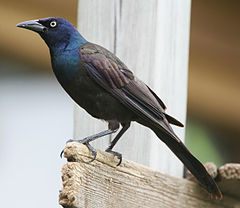
Adult common grackles measure from 28 to 34 cm (11 to 13 in) in length, span 36–46 cm (14–18 in) across the wings and weigh 74–142 g (2.6–5.0 oz).[2] Common grackles are less sexually dimorphic than larger grackle species but the differences between the sexes can still be noticeable. The male, which averages 122 g (4.3 oz), is larger than the female, at an average of 94 g (3.3 oz).[3] Adults have a long, dark bill, pale yellowish eyes and a long tail; its feathers appear black with purple, green or blue iridescence on the head, and primarily bronze sheen in the body plumage. The adult female, beyond being smaller, is usually less iridescent; her tail in particular is shorter, and unlike the males, does not keel (display a longitudinal ridge) in flight and is brown with no purple or blue gloss. The juvenile is brown with dark brown eyes.
Cormorant

Phalacrocoracidae is a family of some 40 species of aquatic birds commonly known as cormorants and shags. Several different classifications of the family have been proposed recently, and the number of genera is disputed. There is no consistent distinction between “cormorants” and “shags”, and these appellations have been assigned to different species randomly.
Cormorants nest in colonies around the shore, on trees, islets or cliffs. They are coastal rather than oceanic birds, and some have colonised inland waters – indeed, the original ancestor of cormorants seems to have been a fresh-water bird. They range around the world, except for the central Pacific islands.
Northern Cardinal

The northern cardinal is a mid-sized songbird with a body length of 21 cm (8.3 in). It has a distinctive crest on the head and a mask on the face which is black in the male and gray in the female. The male is a vibrant red, while the female is a dull reddish olive. The northern cardinal is mainly granivorous, but also feeds on insects and fruit. The male behaves territorially, marking out his territory with song. During courtship, the male feeds seed to the female beak-to-beak. A clutch of three to four eggs is laid, and two to four clutches are produced each year. It was once prized as a pet, but its sale as a cage bird was banned in the United States by the Migratory Bird Treaty Act of 1918.
Ruby Throated Hummingbird

The ruby-throated hummingbird (Archilochus colubris) is a species of hummingbird[a] that generally spends the Winter in Central America and migrates to Eastern North America for the Summer to breed. It is by far the most common hummingbird seen east of the Mississippi River in North America.
This hummingbird is from 7 to 9 cm (2.8 to 3.5 in) long and has an 8 to 11 cm (3.1 to 4.3 in) wingspan. Weight can range from 2 to 6 g (0.071 to 0.212 oz), with males averaging 3.4 g (0.12 oz) against the slightly larger female which averages 3.8 g (0.13 oz).
Blue Jay

The blue jay (Cyanocitta cristata) is a passerine bird in the family Corvidae, native to North America. It is resident through most of eastern and central United States and southern Canada, although western populations may be migratory. It breeds in both deciduous and coniferous forests, and is common near and in residential areas. It is predominantly blue with a white chest and underparts, and a blue crest. It has a black, U-shaped collar around its neck and a black border behind the crest. Genders are similar in size and plumage, and plumage does not vary throughout the year. Four subspecies of the blue jay are recognized.
Cormorants nest in colonies around the shore, on trees, islets or cliffs. They are coastal rather than oceanic birds, and some have colonised inland waters – indeed, the original ancestor of cormorants seems to have been a fresh-water bird. They range around the world, except for the central Pacific islands.
White-breasted Nuthatch
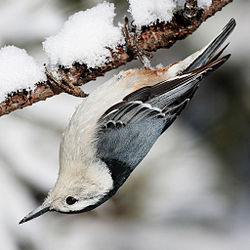
The white-breasted nuthatch (Sitta carolinensis) is a small songbird of the nuthatch family which breeds in old-growth woodland across much of temperate North America. It is a stocky bird, with a large head, short tail, powerful bill, and strong feet. The upperparts are pale blue-gray, and the face and underparts are white. It has a black cap and a chestnut lower belly. The nine subspecies differ mainly in the color of the body plumage.
Mourning Dove
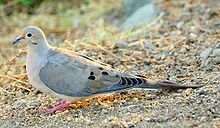
The mourning dove (Zenaida macroura) is a member of the dove family (Columbidae). The bird is also called the turtle dove or the American mourning dove or rain dove, and formerly was known as the Carolina pigeon or Carolina turtledove.[2] It is one of the most abundant and widespread of all North American birds. It is also the leading gamebird, with more than 20 million birds (up to 70 million in some years) shot annually in the U.S., both for sport and for meat. Its ability to sustain its population under such pressure stems from its prolific breeding: in warm areas, one pair may raise up to six broods a year. The wings can make an unusual whistling sound upon take-off and landing, a form of sonation. The bird is a strong flier, capable of speeds up to 88 km/h (55 mph)
American Robin

The American robin (Turdus migratorius) is a migratory songbird of the thrush family. It is named after the European robin because of its reddish-orange breast, though the two species are not closely related, with the European robin belonging to the Old World flycatcher family. The American robin is widely distributed throughout North America, wintering from southern Canada to central Mexico and along the Pacific Coast. It is the state bird of Connecticut, Michigan, and Wisconsin. According to some sources, the American robin ranks behind only the red-winged blackbird (and just ahead of the introduced European starling and the not-always-naturally occurring house finch) as the most abundant extant land bird in North America. It has seven subspecies, but only T. m. confinis of Baja California Sur is particularly distinctive, with pale gray-brown underparts.
Canadian Goose

The Canada goose (Branta canadensis) is a large wild goose species with a black head and neck, white patches on the face, and a brown body. Native to arctic and temperate regions of North America, its migration occasionally reaches northern Europe. It has been introduced to Britain, New Zealand, Argentina, Chile, and the Falkland Islands. Like most geese, the Canada goose is primarily herbivorous and normally migratory; it tends to be found on or close to fresh water.
Mute Swan

The mute swan (Cygnus olor) is a species of swan, and thus a member of the waterfowl family Anatidae. It is native to much of Europe and Asia, and (as a rare winter visitor) the far north of Africa. It is also an introduced species in North America, Australasia and southern Africa. The name ‘mute’ derives from it being less vocal than other swan species. Measuring 125 to 170 cm (49 to 67 in) in length, this large swan is wholly white in plumage with an orange bill bordered with black. It is recognisable by its pronounced knob atop the bill.
House Sparrow

The house sparrow (Passer domesticus) is a bird of the sparrow family Passeridae, found in most parts of the world. A small bird, it has a typical length of 16 centimetres (6.3 inches) and a mass of 24–39.5 grams (0.85–1.39 ounces). Females and young birds are coloured pale brown and grey, and males have brighter black, white, and brown markings. One of about 25 species in the genus Passer, the house sparrow is native to most of Europe, the Mediterranean region, and much of Asia. Its intentional or accidental introductions to many regions, including parts of Australia, Africa, and the Americas, make it the most widely distributed wild bird.
Coyote

The coyote (Canis latrans) is a canid native to North America. It is a smaller, more basal animal than its close relative, the gray wolf, being roughly the North American equivalent to the Old World golden jackal, though it is larger and more predatory in nature. It is listed as “least concern” by the IUCN, on account of its wide distribution and abundance throughout North America, even southwards through Mexico and Central America. It is a highly versatile species, whose range has expanded amidst human environmental modification.
Chipmunk

Chipmunks are small, striped rodents of the family Sciuridae. All species of chipmunks are found in North America, with the exception of the Siberian chipmunk, which is found primarily in Asia.
Chipmunks may be classified either as a single genus, Tamias (Greek: ταμίας), or as three genera: Tamias, which includes the eastern chipmunk; Eutamias, which includes the Siberian chipmunk; and Neotamias, which includes the 23 remaining, mostly western, species.

